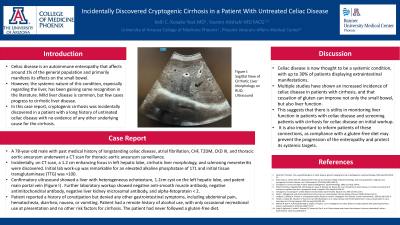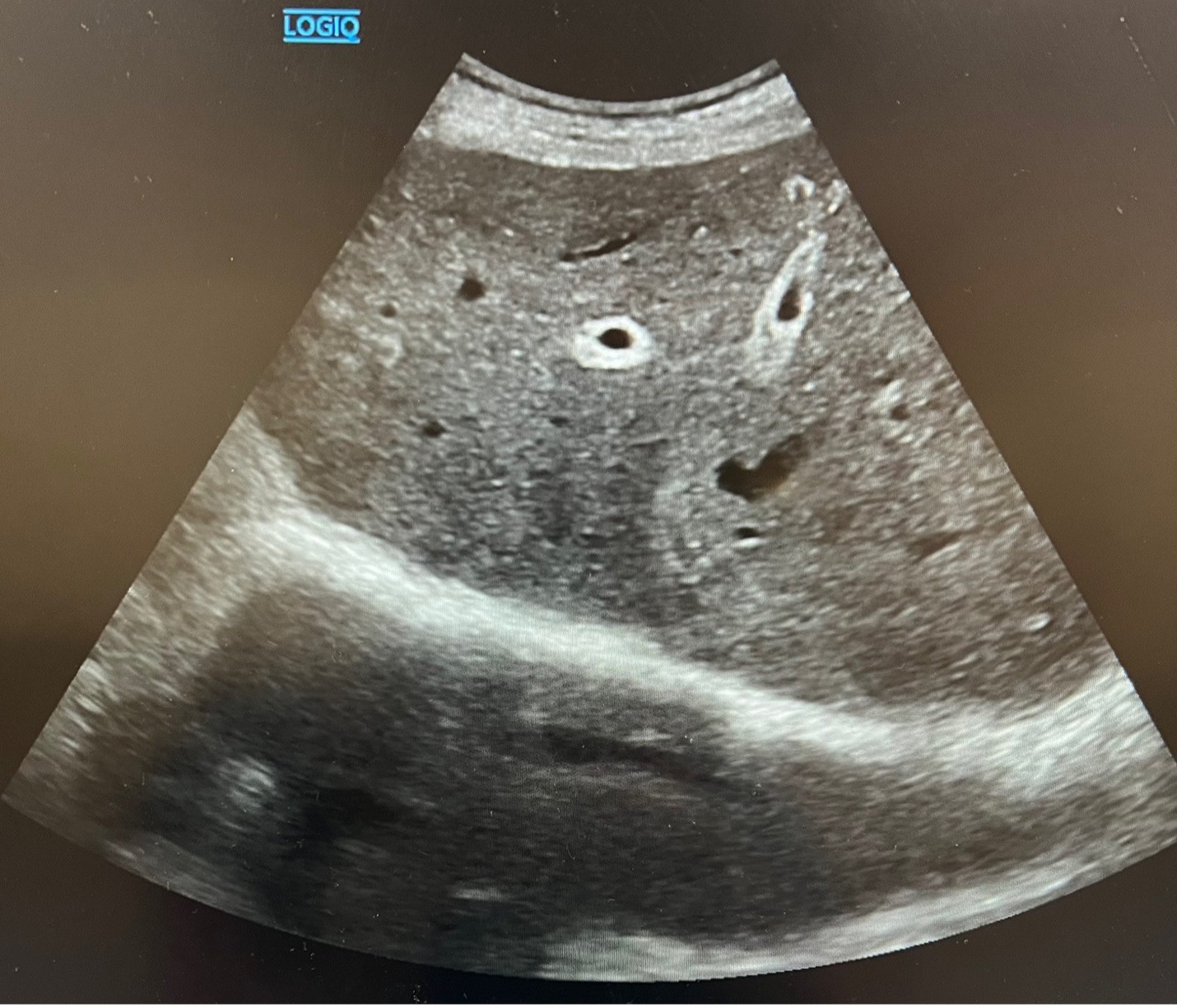Back


Poster Session E - Tuesday Afternoon
Category: IBD
E0422 - Incidentally Discovered Cryptogenic Cirrhosis in a Patient With Untreated Celiac Disease
Tuesday, October 25, 2022
3:00 PM – 5:00 PM ET
Location: Crown Ballroom

Has Audio

Kelli C. Kosako Yost, MD
University of Arizona College of Medicine
Phoenix, AZ
Presenting Author(s)
Kelli C. Kosako Yost, MD, Yasmin Alishahi, MD, FACG
University of Arizona College of Medicine, Phoenix, AZ
Introduction: Celiac disease is an autoimmune enteropathy that affects around 1% of the general population and primarily manifests its effects on the small bowel. However, the systemic nature of this condition, especially regarding the liver, has been gaining some recognition in the literature. Mild liver disease is common, but few cases progress to cirrhotic liver disease. In this case report, cryptogenic cirrhosis was incidentally discovered in a patient with a long history of untreated celiac disease with no evidence of any other underlying cause for the cirrhosis.
Case Description/Methods: A 78-year-old male with past medical history of longstanding celiac disease, atrial fibrillation, CHF, T2DM, CKD III, and thoracic aortic aneurysm underwent a CT scan for thoracic aortic aneurysm surveillance. Incidentally, on CT scan, a 1.2 cm enhancing focus in left hepatic lobe, cirrhotic liver morphology, and sclerosing mesenteritis were discovered. Initial lab work-up was remarkable for an elevated alkaline phosphatase of 171 and initial tissue transglutaminase (TTG) was >100. Confirmatory ultrasound showed a liver with heterogeneous echotexture, 1.2cm cyst on the left hepatic lobe, and patent main portal vein. Further laboratory workup showed negative anti-smooth muscle antibody, negative antimitochondrial antibody, negative liver kidney microsomal antibody, and alpha-fetoprotein < 2. Patient reported a history of constipation but denied any other gastrointestinal symptoms, including abdominal pain, hematochezia, diarrhea, nausea, or vomiting. Patient had a remote history of alcohol use, with only occasional recreational use at presentation. The patient had never followed a gluten-free diet.
Discussion: Celiac disease is now thought to be a systemic condition, with up to 30% of patients displaying extraintestinal manifestations. Multiple studies have shown an increased incidence of celiac disease in patients with cirrhosis, and that cessation of gluten can improve not only the small bowel, but also liver function. This suggests that there is utility in monitoring liver function in patients with celiac disease and screening patients with cirrhosis for celiac disease on initial workup. It is also important to inform patients of these connections, as compliance with a gluten-free diet may prevent the progression of the enteropathy and protect its systemic targets.

Disclosures:
Kelli C. Kosako Yost, MD, Yasmin Alishahi, MD, FACG. E0422 - Incidentally Discovered Cryptogenic Cirrhosis in a Patient With Untreated Celiac Disease, ACG 2022 Annual Scientific Meeting Abstracts. Charlotte, NC: American College of Gastroenterology.
University of Arizona College of Medicine, Phoenix, AZ
Introduction: Celiac disease is an autoimmune enteropathy that affects around 1% of the general population and primarily manifests its effects on the small bowel. However, the systemic nature of this condition, especially regarding the liver, has been gaining some recognition in the literature. Mild liver disease is common, but few cases progress to cirrhotic liver disease. In this case report, cryptogenic cirrhosis was incidentally discovered in a patient with a long history of untreated celiac disease with no evidence of any other underlying cause for the cirrhosis.
Case Description/Methods: A 78-year-old male with past medical history of longstanding celiac disease, atrial fibrillation, CHF, T2DM, CKD III, and thoracic aortic aneurysm underwent a CT scan for thoracic aortic aneurysm surveillance. Incidentally, on CT scan, a 1.2 cm enhancing focus in left hepatic lobe, cirrhotic liver morphology, and sclerosing mesenteritis were discovered. Initial lab work-up was remarkable for an elevated alkaline phosphatase of 171 and initial tissue transglutaminase (TTG) was >100. Confirmatory ultrasound showed a liver with heterogeneous echotexture, 1.2cm cyst on the left hepatic lobe, and patent main portal vein. Further laboratory workup showed negative anti-smooth muscle antibody, negative antimitochondrial antibody, negative liver kidney microsomal antibody, and alpha-fetoprotein < 2. Patient reported a history of constipation but denied any other gastrointestinal symptoms, including abdominal pain, hematochezia, diarrhea, nausea, or vomiting. Patient had a remote history of alcohol use, with only occasional recreational use at presentation. The patient had never followed a gluten-free diet.
Discussion: Celiac disease is now thought to be a systemic condition, with up to 30% of patients displaying extraintestinal manifestations. Multiple studies have shown an increased incidence of celiac disease in patients with cirrhosis, and that cessation of gluten can improve not only the small bowel, but also liver function. This suggests that there is utility in monitoring liver function in patients with celiac disease and screening patients with cirrhosis for celiac disease on initial workup. It is also important to inform patients of these connections, as compliance with a gluten-free diet may prevent the progression of the enteropathy and protect its systemic targets.

Figure: Sagittal View of Cirrhotic Liver Morphology on Right Upper Quadrant Ultrasound
Disclosures:
Kelli Kosako Yost indicated no relevant financial relationships.
Yasmin Alishahi indicated no relevant financial relationships.
Kelli C. Kosako Yost, MD, Yasmin Alishahi, MD, FACG. E0422 - Incidentally Discovered Cryptogenic Cirrhosis in a Patient With Untreated Celiac Disease, ACG 2022 Annual Scientific Meeting Abstracts. Charlotte, NC: American College of Gastroenterology.
